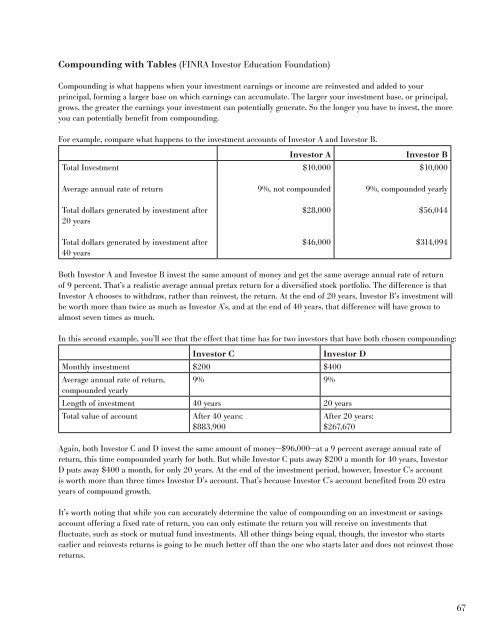Tips and Tools For Financial Success - Newton Free Library
Tips and Tools For Financial Success - Newton Free Library
Tips and Tools For Financial Success - Newton Free Library
Create successful ePaper yourself
Turn your PDF publications into a flip-book with our unique Google optimized e-Paper software.
Compounding with Tables (FINRA Investor Education Foundation)<br />
Compounding is what happens when your investment earnings or income are reinvested <strong>and</strong> added to your<br />
principal, forming a larger base on which earnings can accumulate. The larger your investment base, or principal,<br />
grows, the greater the earnings your investment can potentially generate. So the longer you have to invest, the more<br />
you can potentially benefit from compounding.<br />
<strong>For</strong> example, compare what happens to the investment accounts of Investor A <strong>and</strong> Investor B.<br />
Total Investment<br />
Average annual rate of return<br />
Total dollars generated by investment after<br />
20 years<br />
Total dollars generated by investment after<br />
40 years<br />
Investor A<br />
$10,000<br />
9%, not compounded<br />
$28,000<br />
$46,000<br />
Investor B<br />
$10,000<br />
9%, compounded yearly<br />
$56,044<br />
$314,094<br />
Both Investor A <strong>and</strong> Investor B invest the same amount of money <strong>and</strong> get the same average annual rate of return<br />
of 9 percent. That’s a realistic average annual pretax return for a diversified stock portfolio. The difference is that<br />
Investor A chooses to withdraw, rather than reinvest, the return. At the end of 20 years, Investor B’s investment will<br />
be worth more than twice as much as Investor A’s, <strong>and</strong> at the end of 40 years, that difference will have grown to<br />
almost seven times as much.<br />
In this second example, you’ll see that the effect that time has for two investors that have both chosen compounding:<br />
Investor C<br />
Monthly investment $200 $400<br />
Average annual rate of return,<br />
compounded yearly<br />
9% 9%<br />
Investor D<br />
Length of investment 40 years 20 years<br />
Total value of account<br />
After 40 years:<br />
$883,900<br />
After 20 years:<br />
$267,670<br />
Again, both Investor C <strong>and</strong> D invest the same amount of money—$96,000—at a 9 percent average annual rate of<br />
return, this time compounded yearly for both. But while Investor C puts away $200 a month for 40 years, Investor<br />
D puts away $400 a month, for only 20 years. At the end of the investment period, however, Investor C’s account<br />
is worth more than three times Investor D’s account. That’s because Investor C’s account benefited from 20 extra<br />
years of compound growth.<br />
It’s worth noting that while you can accurately determine the value of compounding on an investment or savings<br />
account offering a fixed rate of return, you can only estimate the return you will receive on investments that<br />
fluctuate, such as stock or mutual fund investments. All other things being equal, though, the investor who starts<br />
earlier <strong>and</strong> reinvests returns is going to be much better off than the one who starts later <strong>and</strong> does not reinvest those<br />
returns.<br />
67




